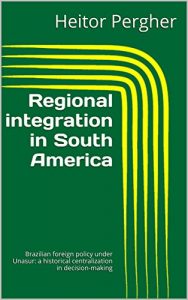To analyze regional integration of South America is certainly not a simple task, since it is a large, complex and heterogeneous process. In order to clarify the issue, it is interesting to refer to the term used by Andrés Malamud (2012, p. 125), who affirms that the regional integration in South America could be characterized as a spaghetti bowl. The author sought to demonstrate by this interesting illustration, that the integration process in South America is characterized by being apparently disordered, without clear leadership and containing numerous initiatives that intertwine and complement each other. I don’t aim to, somehow, make this "spaghetti bowl" more palatable, but to study responsively Brazil's performance in this important institution: UNASUR. Perhaps, in this sense, the study may serve to make regional integration a more understandable question.
It should be emphasized, from the beginning, that integration policies in South America are not dictated by any above state interests, since there is no higher authority to the nation-state that may impose advances contrary to the desired by them. This phenomenon demonstrates that the integration process in South America, contrary to the one observed in Europe, for example, is characterized as an intergovernmental initiative, with no actual transfer of sovereignty powers to supranational entities, quality which was achieved by the European Union.
By analyzing that phenomenon, it’s possible to say the integration existing in the South American subcontinent ends up favoring the sovereign entity status of the State, which keeps untouched its prerogatives, not transferring portions of its sovereignty to supranational entities.
It should be emphasized, from the beginning, that integration policies in South America are not dictated by any above state interests, since there is no higher authority to the nation-state that may impose advances contrary to the desired by them. This phenomenon demonstrates that the integration process in South America, contrary to the one observed in Europe, for example, is characterized as an intergovernmental initiative, with no actual transfer of sovereignty powers to supranational entities, quality which was achieved by the European Union.
By analyzing that phenomenon, it’s possible to say the integration existing in the South American subcontinent ends up favoring the sovereign entity status of the State, which keeps untouched its prerogatives, not transferring portions of its sovereignty to supranational entities.



